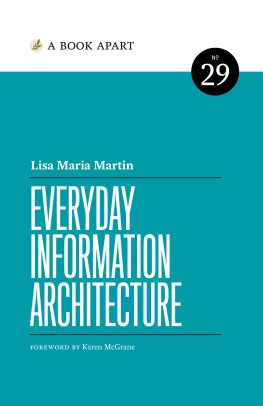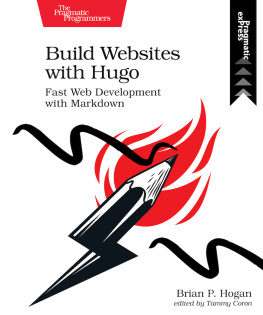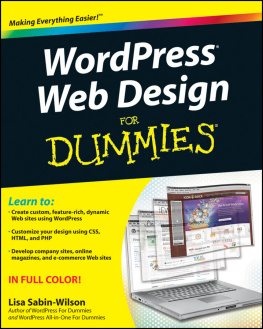I like to think of myself as an organized person. A tangled mess of assorted cables? Sorted into Ziploc bags. Gift wrap and ribbon? Thats why the Container Store exists. Books and music? Dont even question it, lest I spend thirty minutes boring you with a discussion of my own personal metadata manageme nt system.
At least, I used to be an organized person, back when I lived in a 500-square-foot apartment. A couple years ago, I moved to a house three times that size, with a basement. As my possessions drifted across four floors of a row house, I discovered something unpleasant about myself: I hadnt been organized. Id been constrained. Id only been able to find things easily because there were so few places where things could be. In my new home, I struggled to define a system that accommodated new spaces: the guest bathroom, the office closet, the basement cupboard. My identity as an organized person went missingjust like my hammer.
If youre staring down your own web content organization project, this book will be your guide. While you may feel daunted by the prospect of making sense of all the pages and topics and content and ideas and tumbleweeds that have collected on your website over the years, Lisa Maria will walk you through the process of organizing it. When youre done, you wont have to wonder if your content makes sense to the people its there to serve.
Introduction
Walter Plecker was an asshole.
In the 1920s, he was registrar of Virginias Bureau of Vital Statistics, the state government office that controlled birth, death, marriage, and divorce records ( http://bkaprt.com/eia/00-01/ ). As a frothing-at-the-mouth white supremacist, Plecker was terrified of interracial marriage. Its very existence, he insisted, was the result of poor categorization: white people were marrying non-white people only because the government hadnt labeled them c orrectly.
Plecker decided that he could use bureaucracy to change this, and he was right: all he had to do was relabel Virginias racial categories, and racist laws took care of the rest. He reduced the number of racial identity categories to just two, then altered and enforced documentation to reflect his def initions.
This meant that a very small and specific group of people were labeled white, and everyone who fell outside of Pleckers narrow view were notand their lives changed accordingly. The government saw them differently, identified them differently, treated them differently. They no longer had access to the same public spaces, the same schools, the same services and safety nets afforded to white people. Marriages were invalidated. Children were separated from parents. Virginians lost agency over who they wereall because Walter Plecker change d a label.
Changing a label is a design decisionone calculated, in this case, to disenfranchise specific huma n beings.
Now, most of us dont have Walter Pleckers job. We are, instead, designers, developers, copywriters, strategists. We work on the web, and we may not think our work carries that sa me weight.
Im here to argue that it does. Whatever our role, we are designers of information. Our choices alter the presentation and flow of human knowledge. We control how people find, understand, and use information in every facet of th eir lives.
We must be very, ver y careful.
Our work, our resp onsibility
The creative organization of information creates new information, wrote architect Richard Saul Wurman. This axiom is at the core of our work. When we organize informationthat is, when we structure it, order it, display it, label it, connect itwe alter it. We change how information will be perceived, for better or for worse.
Thats a lot of powerpower that we dont always recognize is ours. And when we dont recognize it, we cant be careful about its impact. We risk building sites that arent clear, usable, or inclusive. We risk alienating, even harmi ng, users.
And users have enough cards stacked against them already. Information literacy is low, stress is high, distractions are abundant, and capitalism is a grind. Everyoneusers and web workers alikeis trying to navigate an internet that is both mandatory and hostile, that craves our data but cares little for how it make s us feel.
As builders of the web, we have a responsibility to change that. And we canby being more communicative, more ethical, and more empowering in our organizationa l choices.
The goal of this book is to help you do just that. You may not consider yourself an information architect, but maybe youve been tasked with assessing and categorizing your sites content. Or youve just jumped in on an unfamiliar sitemap project. Or youve never built a taxonomy before. Wherever youre coming from, the principles and practices of information architecture can help you craft more thoughtful informatio n spaces.
Our journey wont be exhaustive when it comes to information architecture, but we will look at the everyday work of the web through a structural lens. In Chapter 1 , well discuss the importance of organizational frameworks. In Chapter 2 , well learn how content can inform strategy and scope. Chapter 3 examines the building blocks of sitemaps, while Chapter 4 shows us how to put them together. In Chapter 5 , well ensure that users can find their way, while Chapter 6 explores the applications (and implications) of ta xonomies.










